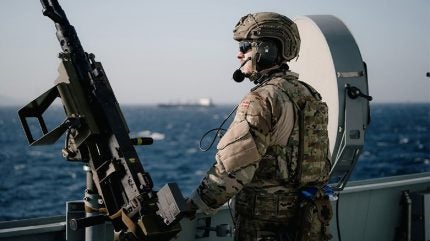
As part of a proposal announced on 13 March to increase defence spending by kr40.5bn ($5.9bn) over the next four years, the Danish Government is focused on expanding ground-based air defence, anti-submarine warfare capabilities, and boosting its existing level of conscripted troops.
Moreover, Ukraine will benefit from $700m from these additional funds in the form of military aid. Previously, Denmark has donated Stinger missiles, rigid hull inflatable boats, CV90 combat vehicles, uncrewed aerial vehicles, and various calibre artillery rounds, among much more.
Until now, Denmark was due to see a 4.7% compound annual growth rate (CAGR) between 2024 to 2028, according to GlobalData intelligence from 2023. The recent expansion in Danish defence will see a greater figure as the Scandinavian nation tries spend 2% of its gross domestic product on the sector by 2030.
“Russia is preparing for a long-term war and could pose a potential threat to nato allies within a few years,” the Danish Defence Minister, Toels Lund Poulsen, anticipates. “Therefore, we must fast-track investment in key military capabilities.”
Supporting Army 1st Brigade
The Danish Government will build-up the Danish Army’s 1st Brigade so it can be deployed in its entirety within the Nato framework.
This includes investments in main battle tanks (MBTs) and infantry fighting vehicles. Other proposed investments include acquisition of ground-based air defence systems – there is already a $1bn missile defence deal with Rheinmetall in the works – to improve protection against enemy air threats.
Presently, the Danish Army operates 44 Leopard 2A7 MBTs that were originally acquired 25 years ago, as well as 44 CV90 units from a decade ago.
The A7 variant is the latest Leopard iteration, so the Army has been keeping up with upgrades since it had acquired the MBTs from the German manufacturer, Krauss-Maffei Wegemann.
As industrial production of platforms, especially with national configuration demands, become ever more difficult to deliver to mobilising countries, defence industry observers have pushed for a greater increase in spiral development. This is a cardinal rule that the UK Ministry of Defence has committed itself toward in its newly reformed procurement process.
Nevertheless, the Danes’ next step will likely be to expand its land fleets by acquiring more Leopard 2 and CV90 units. Ideally with minimal configuration alterations as interoperability becomes a key tenet of the Nato military alliance.
ASW capabilities
The last naval vessels that the Danish Navy procured were its three Huitfeldt-class ASW frigates, with the last vessel inducted in 2016. For that reason, the Navy will implement a similar policy as the Army to expand the fleet.
However, it is notable that Denmark is pursuing ASW capabilities over shipborne missile defence, given the proliferated use of uncrewed aerial systems and sea-based missile strikes so central to Russian strategy unfolding in Ukraine.
Perhaps this focus is a major gap in the Danish inventory considering the country’s strong missile defence system market, which GlobalData estimated would reach a cumulative value of $582m between 2023 and 2028.
Anti-air missile and anti tank guided missiles are also expected to contribute to the growth of this sector with a cumulative investment of $165.1m over the forecast period. Missiles are also the fastest growing sector in the Danish market with a CAGR of 33.6%.
Boost conscription
The Danish Defence Ministry asserted that more military personnel is essential for the Armed Forces’ ability to staff and deploy operational units.
Given the current security situation, there is a need to reform the Danish conscription model, so that conscripts can support Danish Defence to a greater extent.
This echoes voices within Lithuanian defence circles in January to which the Deputy Defence Minister Žilvinas Tomkus observed that changes to the law were necessary to boost personnel.
The Danish Government proposes a new and strengthened model for conscription. The model lengthens the conscription period to 11 months of which the first five months consist of basic military training and education.
In the following six months, conscripts will conduct basic operational tasks in the Armed Forces alongside combined with continuous training and education. The Danish Government proposes a model with approximately 5,000 conscripts per year.



